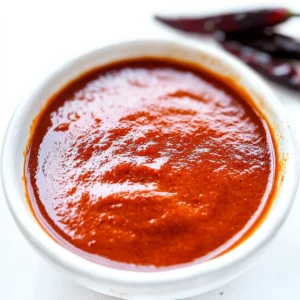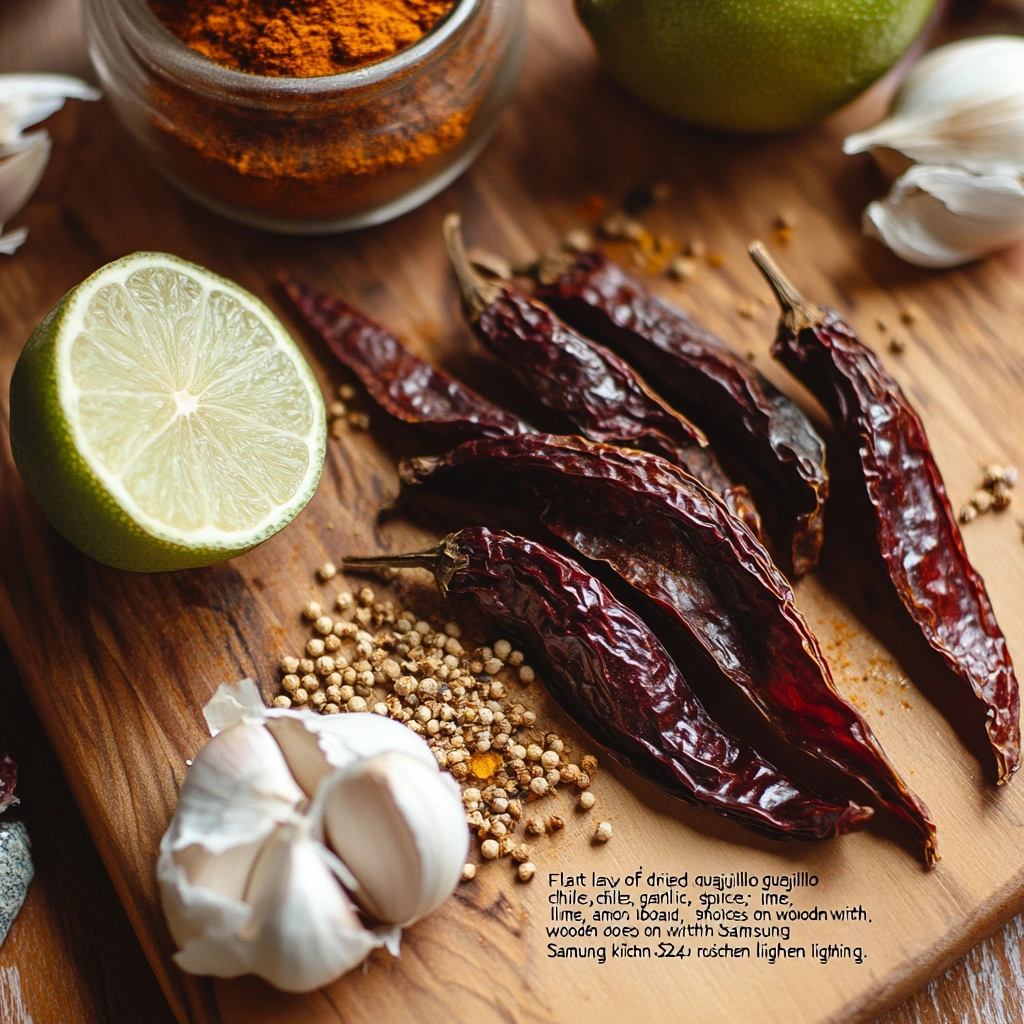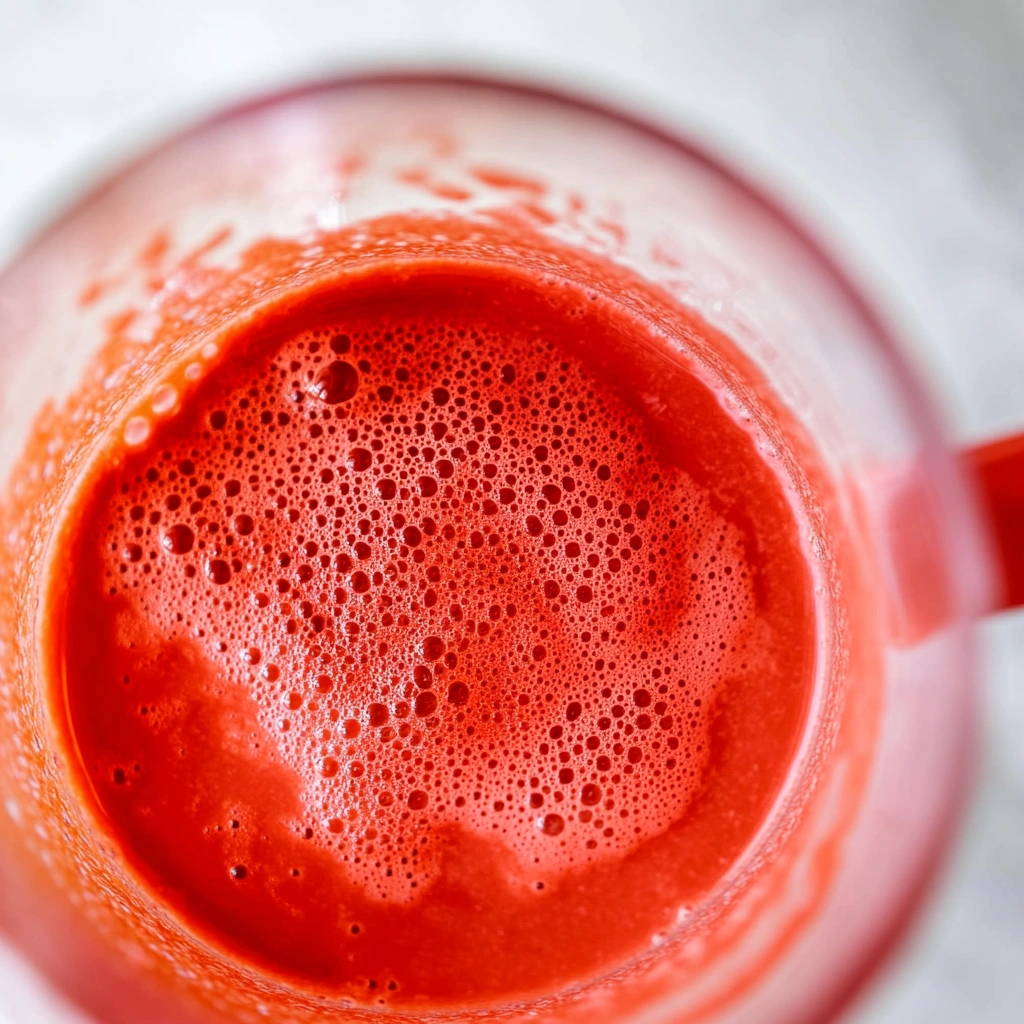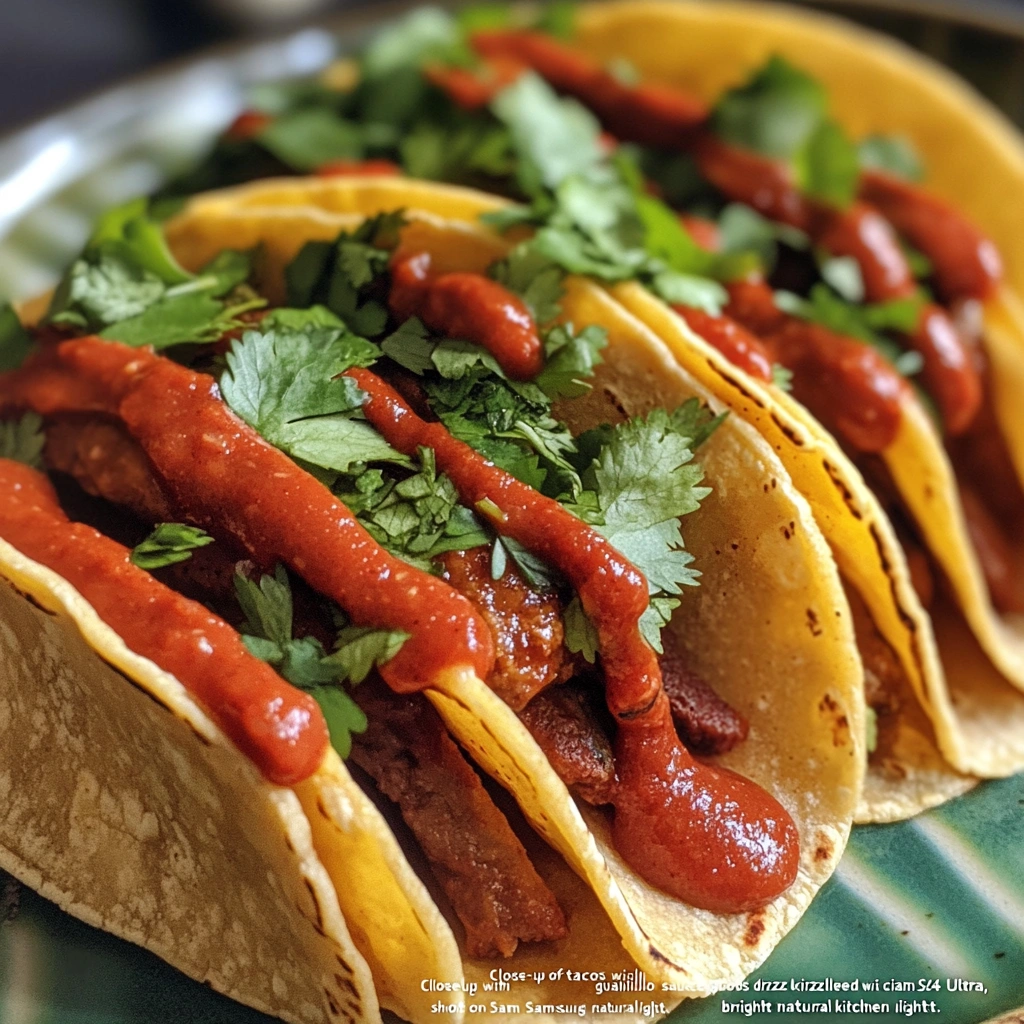Guajillo sauce isn’t just another condiment in my kitchen it’s a piece of my heart. My culinary journey began in the heart of my childhood home, where the kitchen buzzed with laughter, clinking pans, and the rich aroma of spices steeping into slow-cooked stews. It was there, nestled between family traditions and hand-me-down recipes, that I discovered my love for food.
As I grew, I trained in professional kitchens, explored global cuisines, and cooked in spaces ranging from high-end restaurants to modest apartment stoves. But no matter how far I ventured or how many dishes I mastered, one thing remained true: food made with love and simplicity always wins. That’s exactly what this guajillo sauce recipe delivers. It’s easy, bold in flavor, naturally vegan and gluten-free, and versatile enough to elevate any dish from tacos to roasted vegetables.
If you’re looking for a rich, smoky, and slightly sweet chili sauce that won’t overpower your meal, this is the one. Whether you’re feeding a crowd or freezing a batch for later, this family-friendly sauce brings just the right kick to keep everyone coming back for more.
Table of Contents
What Is Guajillo Sauce?
What Is Guajillo Sauce Made Of?
Guajillo sauce, also known as salsa guajillo, is a traditional Mexican red sauce made from rehydrated dried guajillo chiles, blended with garlic, lime juice, cumin, oregano, salt, and a bit of sugar. What makes this sauce stand out is its balance: deep flavor without overwhelming heat.
Unlike fiery hot sauces, guajillo sauce emphasizes smoky and fruity notes, offering a smooth, slightly tangy profile that enhances dishes without dominating them. It’s one of those kitchen staples you’ll find endless uses for whether it’s a topping for enchiladas, a dip for chips, or a vibrant base for marinades and stews.

Guajillo Sauce Recipe
Ingredients
- 5 large dried guajillo chiles stemmed
- 3 garlic cloves
- 1 ¼ cup boiling water to cover
- 3 tablespoons lime juice
- 2 teaspoons granulated sugar of choice I like to use coconut sugar
- 1 teaspoon salt
- 1 teaspoon ground cumin
- ½ teaspoon ground oregano
Instructions
- Instructions
- In a large bowl add the stemmed dried chiles and garlic cloves. Cover with the boiling water, then cover the bowl with a towel and allow the chiles to soak for 20 minutes or until softened.
- Add the chiles, garlic and soaking water to a blender or food processor along with the lime juice, sugar, salt, cumin and oregano.
- Blend until you have a smooth, vibrant red sauce.
- Enjoy!
Notes
Nutrition
History & Cultural Background of Guajillo Peppers
Guajillo peppers are a beloved component of Mexican cuisine, known for their versatility and moderate heat. With roots tracing back to ancient Aztec and Mayan cooking traditions, these chiles were used to season everything from ceremonial dishes to everyday staples.
The term ‘guajillo’ is derived from the Spanish word meaning ‘little gourd,’ which describes the pepper’s slender, glossy, and somewhat curved form.Grown mainly in Mexico, guajillo chiles fall between 2,500 and 5,000 on the Scoville heat scale, making them milder than jalapeños but rich in personality. Over the years, they’ve found their way into global kitchens, bringing a touch of tradition with them.
Whether you’re a home cook or a seasoned chef, understanding this chile’s background deepens your appreciation and unlocks endless culinary potential.
How Spicy Is Guajillo Sauce?
Guajillo Scoville Heat Unit Rating
If you’ve been steering clear of chili sauces because of the heat, good news guajillo sauce is as approachable as it gets. On the Scoville scale, which measures chili pepper spiciness, guajillo peppers rank between 2,500 to 5,000 Scoville Heat Units (SHU). That places them below jalapeños, which typically range from 5,000 to 8,000 SHU.
In practical terms, that means guajillo chiles offer just enough spice to wake up your taste buds without making you sweat. They deliver a warm, mellow heat perfect for families, guests, or anyone who prefers flavor over fire.
Even better, the other ingredients in the recipe like lime juice, cumin, and oregano help round out the heat and balance the flavors, so the end result is satisfying but never overwhelming.
Comparing Guajillo With Other Peppers (Pasilla, Chipotle, Ancho)
So how does guajillo stack up against other popular dried peppers?
| Pepper Type | Heat Level (SHU) | Flavor Profile | Best Use |
|---|---|---|---|
| Guajillo | 2,500 – 5,000 | Smoky, fruity, earthy | Sauces, enchiladas, marinades |
| Pasilla | 1,000 – 2,500 | Rich, sweet, raisin-like | Moles, stews |
| Chipotle | 5,000 – 10,000 | Smoky, hot, deep umami | Salsas, adobo, smoky dishes |
| Ancho | 1,000 – 2,000 | Mild, sweet, slightly smoky | Moles, rubs, red sauces |

- Guajillo vs. Chipotle: Chipotle is spicier and smokier, but guajillo has a fruitier nuance that’s better for milder palates.
- Guajillo vs. Pasilla: Pasilla is softer and sweeter, ideal for mole, while guajillo has a slightly sharper and tangier finish.
- Guajillo vs. Ancho: Both are mild, but guajillo brings more brightness and acidity to a dish.
This comparison shows why guajillo is often chosen for sauces: it strikes a unique balance that’s hard to replicate.
Ingredients You’ll Need for This Guajillo Sauce Recipe
Key Ingredients and Alternatives
This guajillo sauce recipe is both bold and flavorful, while being incredibly easy to make with minimal preparation.. Below is a breakdown of each ingredient, why it’s important, and what you can substitute if needed.
| Ingredient | Purpose | Substitutes |
|---|---|---|
| Dried Guajillo Chiles | Base of the sauce; mild heat + fruity & smoky flavor | Dried pasilla chiles or dried ancho chiles |
| Garlic Cloves | Adds depth and pungent aroma | Roasted garlic or garlic powder (1 tsp) |
| Boiling Water | Softens the dried chiles for blending | Vegetable broth for added flavor |
| Lime Juice | Balances heat and adds tang | Lemon juice or apple cider vinegar |
| Sugar (e.g. coconut sugar) | Enhances flavor and balances acidity | Any granulated sugar or keto-friendly sweetener |
| Salt | Enhances the taste of all ingredients | Sea salt, kosher salt, or pink Himalayan |
| Ground Cumin | Adds warmth and smoky depth | Smoked paprika or coriander (in moderation) |
| Ground Oregano | Adds herbal complexity | Preferably Mexican oregano; regular works too |
This sauce is naturally:
- Vegan
- Gluten-Free
- Dairy-Free
- Soy-Free
- Nut-Free
- Onion-Free
- And No-Cook after blending!

That means just about anyone at your table can enjoy this versatile red sauce.
Why This Guajillo Sauce Is Naturally Gluten-Free, Vegan, and Allergy-Friendly
One of the standout features of this recipe is how inclusive it is. There’s no flour, no dairy, and no hidden allergens. It’s built purely from natural, whole ingredients, making it a great addition to any dietary lifestyle.
Here’s why that matters:
- For Vegans: No need to skip out on smoky red enchilada sauces anymore.
- For Gluten-Free Diets: This sauce uses zero thickening agents or wheat-derived components.
- For Sensitive Eaters: It’s onion-free and can be customized with low-FODMAP adjustments.
You get bold, authentic flavor without compromising your health or your guests’ needs.
Easy Step-by-Step Recipe for Guajillo Sauce
Preparing and Soaking the Chiles
The first and most important step in making guajillo sauce is properly preparing the dried chiles. This not only rehydrates them but also softens their skins so they blend into a smooth, silky texture.
Step-by-Step Prep:
- Remove the Stems and Seeds:
Cut the stems off of five large dried guajillo chiles.. Shake out most of the seeds (you can leave a few if you want a touch more heat). - Soak the Chiles:
Place the guajillo chiles and 3 peeled garlic cloves in a large bowl.
Pour 1¼ cups of boiling water over them. Cover with a towel and let soak for 20 minutes or until completely softened.
This soaking step brings out the natural oils in the chiles, releasing their signature smoky-fruity flavor.
Blending and Adjusting for Taste (Salt, Sugar, Acid Balance)
Now it’s time to blend everything into a velvety red sauce you’ll want to put on everything.

Step-by-Step Blending:
- Add All Ingredients to a Blender:
Combine the softened chiles and garlic with the soaking liquid, then add:- 3 tablespoons lime juice
- 2 teaspoons granulated sugar (or coconut sugar)
- 1 teaspoon salt
- 1 teaspoon ground cumin
- ½ teaspoon ground oregano
- Blend Until Smooth:
Blend on high for 30–60 seconds until the mixture becomes a smooth, vibrant red sauce. Scrape down the sides as needed. - Taste and Adjust:
Want it tangier? Add a bit more lime juice. Too acidic? A pinch more sugar will balance it out. Need more depth? A sprinkle more cumin or salt can do the trick.
This step is where you customize your sauce to make it truly your own.
Final Tips:
- If the sauce is too thick, you can thin it with a splash of water or broth.
- Store leftovers in an airtight jar in the fridge for up to 10 days.
- This recipe makes about 1½ cups of sauce perfect for a family meal or to freeze for later.
Uses for Guajillo Sauce Beyond Mexican Dishes
Guajillo Sauce as Enchilada Sauce
One of the most classic and beloved uses for guajillo sauce is as a base for red enchiladas. The sauce clings beautifully to corn tortillas, and its balanced flavor profile mild heat, earthy depth, and citrusy tang makes it a star.
Easy enchilada idea:
- Corn tortillas
- Shredded Monterey Jack cheese
- A generous pour of guajillo sauce
Bake until bubbly, and you’ve got a cheesy, comforting dinner with minimal effort and maximum flavor.
Serving Ideas: Dipping Sauce, Topping for Eggs, Fries, Tacos, and More
This sauce may be rooted in Mexican tradition, but it’s incredibly adaptable. Here are some creative and delicious ways to bring it into your everyday cooking:
1. Taco Night Hero
Drizzle guajillo sauce over grilled meats, roasted vegetables, or black bean tacos. It adds brightness and character without overwhelming the fillings.

2. Quesadilla or Chip Dip
Use it like a salsaserve warm or chilled next to crispy quesadillas, tortilla chips, or even as a smoky dip for French fries.
3. Eggs and Brunch Dishes
Turn a basic breakfast into a standout dish. Spoon it over scrambled eggs, sunny-side-ups, or breakfast potatoes for a bold, savory kick.
4. Meat Marinade or Sauce Base
Use guajillo sauce as a marinade for chicken, pork, or tofu before roasting or grilling. You can also stir it into soups or stews for smoky complexity.
5. Pasta Twist
Feeling creative? Add it to a red pasta sauce or blend with sour cream or Greek yogurt to make a spicy crema for wraps and sandwiches.
This sauce doesn’t just live in the “Mexican food” category it travels well across cuisines.
Storage Tips and Meal Prep Ideas
How Long Guajillo Sauce Lasts in the Fridge and Freezer
One of the best things about this guajillo sauce recipe aside from how delicious it is is how well it keeps. Whether you’re meal prepping or just making extra to have on hand, this sauce stores beautifully.
In the Refrigerator:
- Use an airtight glass jar or a BPA-free container for storage.
- Keeps fresh for up to 10 days
- To avoid any contamination, make sure to use a clean spoon.
In the Freezer:
- Pour into freezer-safe containers or silicone molds for easy portioning
- Freeze for up to 3 months
- Thaw in the refrigerator overnight or microwave on low to reheat
Pro tip: If you want to store single portions, freeze it in an ice cube tray first. Once frozen, pop the cubes into a zip-top bag for grab-and-go convenience.
Looking for inspiration? Try our Easy Kimchi Recipe another fermented dish that stores well and packs bold flavor.
Batch Cooking Tips and Serving Sizes
This guajillo chili sauce is a smart make-ahead addition to any cooking routine. Whether you’re meal prepping for the week or hosting a taco night, having this sauce ready to go saves time and elevates your meals.
Batch Prep Guide:
- Double or triple the recipe using a high-powered blender
- Label storage containers with the date
- Consider separating into “taco night” and “enchilada night” portions for faster planning
Serving Suggestions:
- 2–3 tablespoons per taco
- ½ cup per enchilada plate
- 1 tablespoon for drizzling or dipping
Because this recipe is so forgiving, you can easily scale it up or down without losing flavor.
Guajillo vs. Chipotle: What’s the Difference?
Taste, Heat, and Usage Comparison
Guajillo and chipotle chiles are often used interchangeably by home cooks, but they bring very different things to the table. Understanding their distinctions can help you choose the right one for your dish.
Let’s break it down:
| Feature | Guajillo | Chipotle |
|---|---|---|
| Heat Level | Mild (2,500–5,000 SHU) | Medium to hot (5,000–10,000 SHU) |
| Flavor | Fruity, earthy, slightly smoky | Richly smoky, strong, with a touch of sweetness |
| Texture | Thin-skinned, dries easily for blending | Thicker, typically packed in adobo sauce |
| Color | Reddish-brown | Dark red to deep brown |
| Usage | Sauces, salsas, enchiladas, marinades | BBQ sauces, smoky salsas, meat rubs |
- Guajillo shines when you want flavor without overwhelming heat. It’s more subtle, with a fresher fruit-like note and dry finish.
- Chipotle, a smoked and dried jalapeño, delivers a powerful smokiness that tends to dominate other ingredients. It’s great for grilling and bold sauces but less versatile than guajillo.
If you’re feeding a crowd with mixed spice tolerances, guajillo sauce is the safer, more family-friendly option.
When to Use Guajillo vs. Chipotle in Recipes
So when should you grab guajillo, and when should you go with chipotle? Here’s a quick guide:
Choose Guajillo When:
- You’re making red enchilada sauce, taco topping, or chili base
- You want a versatile, not-too-spicy red sauce
- You’re cooking for kids or spice-sensitive eaters
- You’re creating a sauce that complements not overpowers other flavors
Choose Chipotle When:
- You want bold smoke to stand out
- You’re grilling meats or making BBQ sauce
- You need heat and richness in a stew or rub
- You’re preparing a smoky adobo marinade or dressing
Each chili has its moment, but for day-to-day meals and wide appeal, guajillo sauce delivers unmatched flavor flexibility.
Conclusion: Why Guajillo Sauce Deserves a Place in Your Kitchen
Guajillo sauce is one of those rare recipes that blends simplicity, versatility, and bold flavor all in one jar. Whether you’re a seasoned cook or just starting your culinary journey, this sauce adds something special to every dish it touches—from enchiladas to eggs to creative pasta sauces.
Its mild heat makes it family-friendly, while the deep, smoky-fruity notes bring gourmet complexity without needing professional skills. And with just a few pantry staples, you can create a sauce that rivals your favorite restaurant’s version—only fresher, cleaner, and completely customizable.
So next time you’re craving something that elevates your everyday meals without overpowering them, give this guajillo sauce a shot. You’ll find yourself reaching for it again and again.
Looking for inspiration? Try these great pairings and ideas:
- Chipotle Chilis in Adobo Sauce
- Cheese Stuffed Poblano Peppers
- Carne Adovada Slow Cooker
- Habanero Pepper Hot Sauce Recipe
for more recipes follow facebook and pintrest
Guajillo Sauce FAQs Answered
What is a guajillo sauce?
Guajillo sauce is a classic Mexican red chile sauce made primarily from dried guajillo peppers. It’s known for its rich color, smoky-fruity flavor, and mild heat. The sauce is commonly used in enchiladas, tacos, and stews and is often referred to as salsa guajillo. It’s naturally vegan, gluten-free, and incredibly versatile.
What does guajillo taste like?
Guajillo peppers have a distinctive taste that’s slightly sweet, earthy, and tangy with notes of dried fruit and smoke. When blended into a sauce, they create a bold flavor without being overly spicy. The result is a balanced, complex taste that pairs well with both meats and vegetables.
How spicy is guajillo?
Guajillo chiles sit between 2,500 to 5,000 Scoville Heat Units (SHU), making them mild to moderately spicy. Most people find guajillo sauce pleasantly warm rather than hot. It’s an excellent choice for those who want flavor with just a hint of heat.
Are guajillo and chipotle the same?
No, they’re not the same. While both are dried chiles used in Mexican cuisine, guajillo is a dried mirasol chile, and chipotle is a smoked and dried jalapeño. Chipotle is smokier and hotter, whereas guajillo is fruitier, milder, and more versatile in sauces.
What is a good recipe for guajillo sauce?
A great recipe starts with:
5 dried guajillo chiles
3 garlic cloves
1¼ cups boiling water
3 tablespoons lime juice
2 teaspoons sugar
1 teaspoon salt
1 teaspoon cumin
½ teaspoon oregano
Soak the chiles and garlic in hot water, blend with the rest of the ingredients until smooth, and adjust to taste. That’s it! An easy, flavorful base for countless dishes.
What does guajillo sauce taste like?
The final guajillo sauce is smooth, smoky, tangy, and just slightly sweet. Its flavor deepens when used in cooked dishes like enchiladas, but it’s also delicious served raw as a salsa-style dip or taco topping.
What is in guajillo sauce?
Guajillo sauce typically includes:
Dried guajillo chiles
Garlic
Water or broth
Lime juice
Sugar
Salt
Ground cumin
Ground oregano
These ingredients blend into a bold yet mellow red sauce that enhances any dish.
How to pronounce Guajillo Sauce?
“Guajillo” is pronounced [gwah-HEE-yoh]. The “j” is pronounced like an English “h,” and the double “l” makes a “y” sound—common in Spanish. So, it’s gwah-HEE-yoh, not gwa-jill-oh.
Substitutes for guajillo sauce
If you can’t find guajillo chiles, try these substitutes:
Dried pasilla peppers – similar in heat and slightly richer in flavor
Ancho chiles – sweeter and milder
Chipotle (in small amounts) – smokier and hotter, so adjust for heat
New Mexico red chiles – if you want a smoother, milder sauce with a similar red hue
For a smoky twist, you can also mix ancho and chipotle together, but keep in mind the heat and flavor balance.

